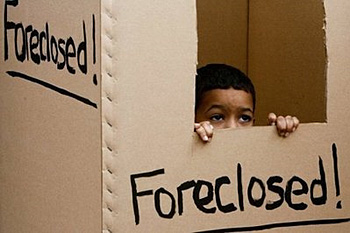US Foreclosures Rise Again
 Alex Veiga - Associated Press Alex Veiga - Associated Press
go to original
September 16, 2010


| | (AFP) |  |
Lenders took back more homes in August than in any month since the start of the U.S. mortgage crisis.

The increase in home repossessions came even as the number of properties entering the foreclosure process slowed for the seventh month in a row, foreclosure listing firm RealtyTrac Inc. said Thursday.

In all, banks repossessed 95,364 properties last month, up 3 percent from July and an increase of 25 percent from August 2009, RealtyTrac said.

August makes the ninth month in a row that the pace of homes lost to foreclosure has increased on an annual basis. The previous high was in May.

Banks have been stepping up repossessions to clear out their backlog of bad loans with an eye on eventually placing the foreclosed properties on the market, but they can’t afford to simply dump the properties on the market.

Concerns are growing that the housing market recovery could stumble amid stubbornly high unemployment, a sluggish economy and faltering consumer confidence. U.S. home sales have collapsed since federal homebuyer tax credits expired in April.

That’s one reason fewer than one-third of homes repossessed by lenders are on the market, said Rick Sharga, a senior vice president at RealtyTrac.

“These (properties) are going to come to market, but very slowly because nobody wants to overwhelm a soft buyer’s market with too much distressed inventory for fear of what it would do for house prices,” he said.

As a result, lenders are putting off initiating the foreclosure process on homeowners who have missed payments, letting borrowers stay in their homes longer.

The number of properties receiving an initial default notice — the first step in the foreclosure process — slipped 1 percent last month from July, but was down 30 percent versus August last year, RealtyTrac said.

Initial defaults have fallen on an annual basis the past seven months. They peaked in April 2009.

Still, the number of homes scheduled to be sold at auction for the first time increased 9 percent from July and rose 2 percent from August last year. If they don’t sell at auction, these homes typically end up going back to the lender.

More than 2.3 million homes have been repossessed by lenders since the recession began in December 2007, according to RealtyTrac. The firm estimates more than 1 million American households are likely to lose their homes to foreclosure this year.

In all, 338,836 properties received a foreclosure-related warning in August, up 4 percent from July, but down 5 percent from the same month last year, RealtyTrac said. That translates to one in 381 U.S. homes.

The firm tracks notices for defaults, scheduled home auctions and home repossessions — warnings that can lead up to a home eventually being lost to foreclosure.

Among states, Nevada posted the highest foreclosure rate last month, with one in every 84 households receiving a foreclosure notice. That’s 4.5 times the national average.

Rounding out the top 10 states with the highest foreclosure rate in August were: Florida, Arizona, California, Idaho, Utah, Georgia, Michigan, Illinois and Hawaii.

Economic woes, such as unemployment or reduced income, are now the main catalysts for foreclosures.

Lenders are offering a variety of programs to help homeowners modify their loans, but their success rates vary. Hundreds of thousands of homeowners can’t qualify or fall back into default.

The Obama administration has rolled out numerous attempts to tackle the foreclosure crisis but has made only a small dent in the problem. Nearly half of the 1.3 million homeowners who enrolled in the Obama administration’s flagship mortgage-relief program have fallen out.

The program, known as Making Home Affordable, has provided permanent help to about 390,000 homeowners since March 2009.

Regardless, many troubled borrowers have seen their efforts to get a loan modification stymied.

Larry Book of Winter Garden, Fla., was one packet away from a permanent loan modification from Chase under the Obama administration’s foreclosure prevention plan after more than a year of back and forth and one failed attempt.

But his modification never went through. Instead, his loan was transferred from Chase to IBM Lender Business Process Servicers in July and he was told he owed $9,562.62 and must bring his mortgage current by Sept. 15 or foreclosure proceedings will begin.

“It just becomes too exhausting,” Book said about the modification process. “That’s why some people walk away. But I’ve invested too much and given up too much to just let it go.”

AP Real Estate Writer J.W. Elphinstone in New York contributed to this report. |



